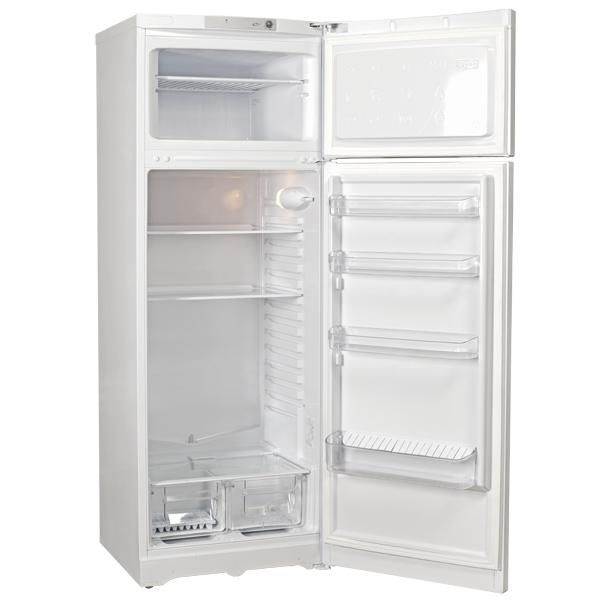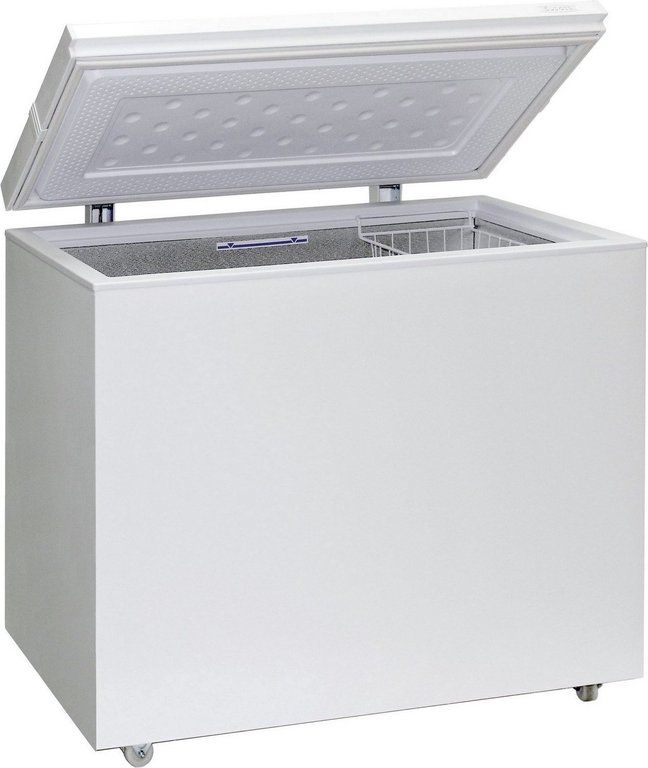What vegetables can be frozen in the freezer?
Surely everyone, when cooking, has encountered a surplus of fresh vegetables that you don’t want to throw away, but have absolutely nowhere to put it. It also often happens that purchased vegetables are not enough and you have to buy new ones. It’s easy to avoid these unpleasant situations - just learn how to freeze vegetables correctly so that you always have enough of them.
The content of the article
Why do you need to freeze vegetables?
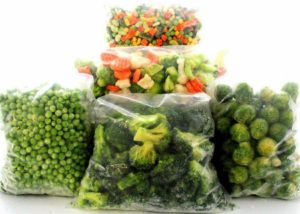 During the period of active consumption of greens and other products from the garden, few people may need to store vegetables in the freezer. Perhaps the most loyal housewives to vegetable dishes, who are unable to calculate the required amount for daily cooking - it really wouldn’t hurt for them to have several types of the most necessary products in the freezer.
During the period of active consumption of greens and other products from the garden, few people may need to store vegetables in the freezer. Perhaps the most loyal housewives to vegetable dishes, who are unable to calculate the required amount for daily cooking - it really wouldn’t hurt for them to have several types of the most necessary products in the freezer.
Important! The preparation can be useful even for those who do not particularly like to cook. Fresh vegetables are a scarce material for making masks for skin and hair.
But in the winter and autumn, when fresh vegetables are not available (or cannot be bought at reasonable prices), the habit of freezing healthy food supplies can come in handy.What vegetables can be frozen in the freezer? Having a large freezer, you can put aside fresh vegetables or herbs for the winter, chopping them in advance to save space and time. This can be done with cucumbers, tomatoes, peppers - all these products are not stored under normal conditions.
General rules for freezing fruits and vegetables in the freezer
 First and foremost, monitor the temperature. The principle “the lower the better” will not apply here. The optimal temperature for frozen vegetables in the chamber is from -18 to -23 C. At lower temperatures (toward the heat), the juiciest vegetables may not have time to freeze immediately and will release juice, which will then turn into unpleasant ice. At high temperatures (in the cold direction), the products will harden so much that they may lose their beneficial and tasteful qualities.
First and foremost, monitor the temperature. The principle “the lower the better” will not apply here. The optimal temperature for frozen vegetables in the chamber is from -18 to -23 C. At lower temperatures (toward the heat), the juiciest vegetables may not have time to freeze immediately and will release juice, which will then turn into unpleasant ice. At high temperatures (in the cold direction), the products will harden so much that they may lose their beneficial and tasteful qualities.
Important! The ideal container for vegetables would be plastic containers. You can use disposable ones, like the ones they sell berries in in supermarkets.
Label the containers that will contain vegetables. After a few months, you won't remember where you put anything, so it may be difficult to find specific products.
Features of freezing food in bags
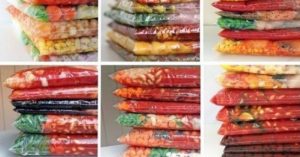 What can you freeze in the freezer in bags? Not everyone will have the opportunity to use plastic containers as containers, and besides, this is not very space-efficient if you have big plans for the preparation.
What can you freeze in the freezer in bags? Not everyone will have the opportunity to use plastic containers as containers, and besides, this is not very space-efficient if you have big plans for the preparation.
A good replacement would be bags, but not simple cellophane ones (although, in the absence of alternatives, you can take them too), but denser ones, with a clasp in the form of a snap-on tape. These can be found in the household goods or office supply department.
Look for medium-sized bags, because large ones will accumulate moisture and turn into ice, no matter how carefully you pack them. Try to fill the space inside the bag correctly - don’t fill it all the way, but don’t leave any air. The bag should be as close to vacuum as possible.
Freezing Seasonings
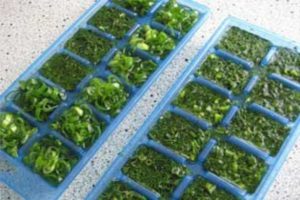 Contrary to many myths that greens are useless after being frozen, freeze them, as well as many herbs like tarragon, bay leaves, lemon balm, rosemary, etc. Can. Nothing will happen, and if you pack the seasonings correctly, you will get them out in exactly the same condition in which you put them.
Contrary to many myths that greens are useless after being frozen, freeze them, as well as many herbs like tarragon, bay leaves, lemon balm, rosemary, etc. Can. Nothing will happen, and if you pack the seasonings correctly, you will get them out in exactly the same condition in which you put them.
How to prepare seasonings for the freezer:
- wash them and leave them to dry for several hours - as little moisture as possible should remain on the stems and leaves;
- do not overdo it, do not let the plants wither;
- It is better to fill the container tightly (both the bag and the plastic);
- You don’t have to worry about the fate of these seasonings throughout the winter season - they will be safe and sound in the chamber.
Freezing mixed vegetables
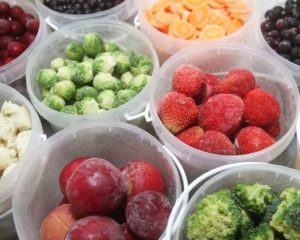 What foods can be frozen in the freezer? On store shelves you can often see ready-made semi-finished vegetable products - mixtures of different vegetables combined in one package. You can make this preparation yourself, based on your personal preferences in cooking. For example, you can make your own signature vegetable set for borscht, stew, and stew.
What foods can be frozen in the freezer? On store shelves you can often see ready-made semi-finished vegetable products - mixtures of different vegetables combined in one package. You can make this preparation yourself, based on your personal preferences in cooking. For example, you can make your own signature vegetable set for borscht, stew, and stew.
How to do it:
- Select all the vegetables you need (take large, high-quality specimens without scuffs and rot, this is important), rinse and dry them well;
- Cut the vegetables into cubes (auxiliary products that do not play a big role in the future dish can be grated to save space);
- Stir, remove juice if any;
- Dry it a little more and place it tightly in the bag like this (but not so that it literally bursts - remember that cold expands objects).
Important! For vegetable mixtures, heavy-duty bags are better than containers. A zipper on the bag will be very useful if the product is designed for many servings.
How to Freeze to Keep Vegetables Fresh
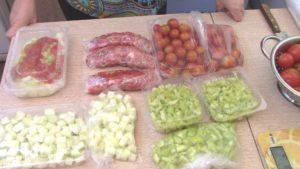 The whole secret here is in the correct grinding. For example, to get fresh tomatoes after several months in the freezer, you need to cut them into slices or circles. Thin slices will quickly be set by frost and will not have time to turn into tomato porridge, losing all the juice. To prevent the tomatoes from sticking together, freeze them a little on a board or plate before adding them to the bag.
The whole secret here is in the correct grinding. For example, to get fresh tomatoes after several months in the freezer, you need to cut them into slices or circles. Thin slices will quickly be set by frost and will not have time to turn into tomato porridge, losing all the juice. To prevent the tomatoes from sticking together, freeze them a little on a board or plate before adding them to the bag.
Cucumbers cannot be frozen in thin slices - the vegetable is too watery and will definitely stick together from the cold. It needs to be cut into cubes; this shape is great for salads; you shouldn’t be biased about it if you’ve never tried it.
The carrots can be cut into long “quarters” if you need them for salads and stews, or grated on a coarse/fine grater if you are freezing them for first courses or stews.
Do not throw vegetables into the chamber immediately, this will cause a sharp temperature change. Prepare them in the refrigerator for several hours to allow the food to cool properly.




